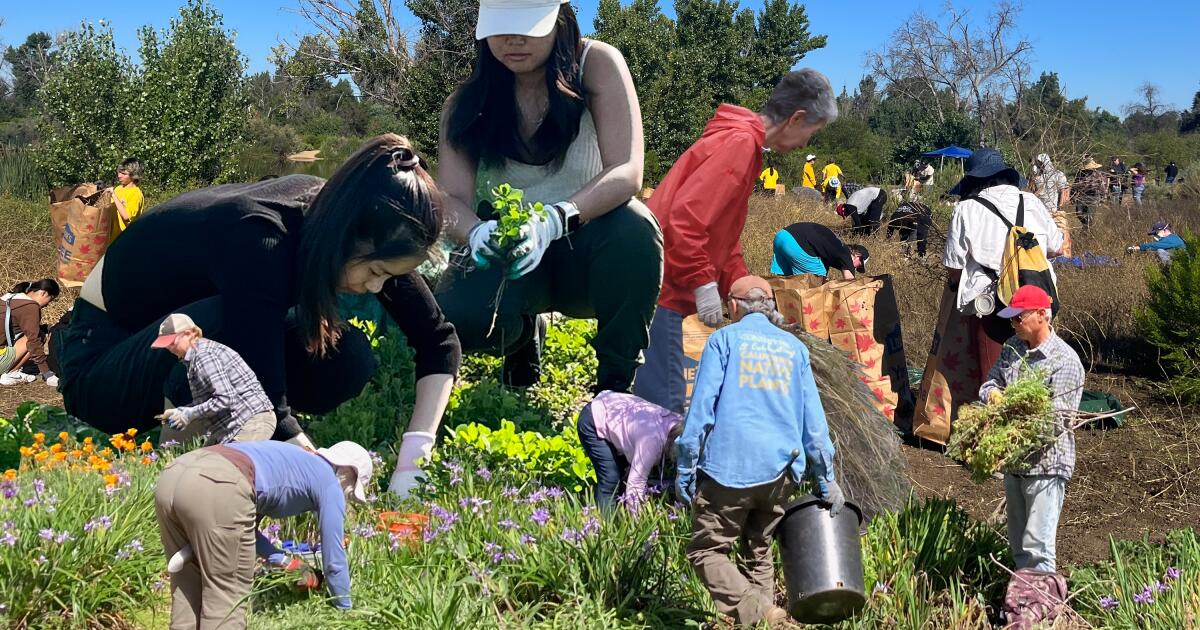Back then, I knew very little about these native plants — not even their names. Even though my mom was a gardener who’d take me to visit local nurseries, my understanding of plants didn’t go very deep. Like many of us, I assumed that lush green lawns and tall, limber palm trees were the signature plant life of Los Angeles. Volunteering as an adult has changed that.
When I first went to visit the nursery at the Theodore Payne Foundation in Sun Valley, I remember being captivated by the little Joshua Tree sprouts they were selling in tiny 4-inch pots — these are plants that have been in our local Mojave Desert for over tens of thousands of years. I signed up to volunteer there because I had a feeling that these plants were part of the profound story of this place. I wanted to know more.
The first volunteer day I attended was a group cleanup session of the grounds, which feels more like a nature park than most nurseries. There are billowing buckwheats, dramatically sculptured manzanitas, as well as sages and a big palo verde tree with its long green spreading limbs. The plants attract butterflies, bees, birds and other critters. It was easy to spend time there.
We got to work doing chores around the nursery, pulling weeds and raking leaf litter away from shrubs. Chitchat among the 15 volunteers ensued, piles of weeds formed. We were working as a team, with people taking the lead or following along as necessary, some carrying the weight and others providing encouragement. We probably worked for the better part of three hours, but it didn’t seem like it.
I didn’t realize it at the time, but I was experiencing the seeds of many revelations. I began to notice how even the simplest tasks such as pulling weeds can be a meditation. Working outside with plants is not only relaxing, but it makes you more aware of life in many ways. Being part of a group effort showed me how much a few people working toward the same goal could accomplish in a short amount of time.
Sign up for our L.A. Times Plants newsletter
At the start of each month, get a roundup of upcoming plant-related activities and events in Southern California, along with links to tips and articles you may have missed.
You may occasionally receive promotional content from the Los Angeles Times.
Pretty soon I was helping customers in the sales yard, doing things like checkout and carting plants out to cars. I got to work with the point-of-sale computers, entering in the items people had purchased, and this helped me learn many of the plant names, both the common and the scientific ones. I started to recognize plants and pick up basic identification skills.
The sales yard staff is constantly talking to shoppers. Sometimes they’re talking to professionals, but often to complete beginners about native plants, or even regarding gardening in general. I got to witness and be a part of these conversations, which helped me learn a lot fairly quickly. I was becoming part of a larger conversation about the plants that reflect the story of California.
Since that first time at Theodore Payne, I’ve volunteered with a handful of other plant-related organizations, including the California Native Plant Society, Friends of Griffith Park and Arlington Garden in Pasadena, where I now work. At Arlington Garden, a big part of my job is working with volunteers.
The other day I helped lead a group of college students volunteering at Arlington Garden, pulling weeds and turning them into compost. Now I get to see others experience the benefits of volunteering with plants – something I would never have imagined that day I was delighted by the tiny Joshua Trees.
Almost every weekend you can find volunteering opportunities at plant spaces around Southern California. Use this guide to get started. When you sign up to volunteer, confirm the event address with the organization. Events may take place beyond the sites marked on the map. — William Hallstrom
